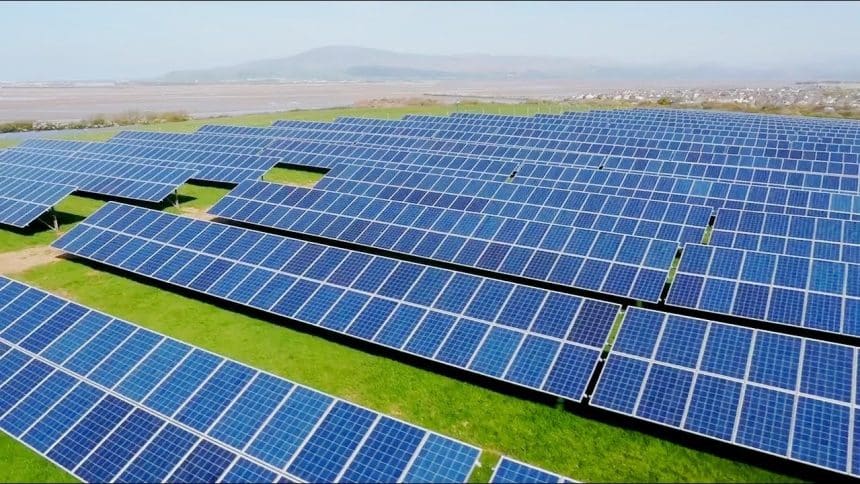Indonesia enters 2026 with ambitious economic growth targets, and the energy sector is a crucial foundation for achieving them. The government, along with PLN, has released the 2025–2034 RUPTL (Land Use Plan) dubbed the “Greenest RUPTL in History,” targeting an additional 69.5 GW of electricity capacity—with more than 76% coming from renewable energy sources such as solar power plants (PLTS), hydropower plants (PLTA), wind power plants (WPP), geothermal energy, and large-scale energy storage projects. This ambitious target is a strong signal that Indonesia is preparing for a national energy transformation that is cleaner, more modern, and more resilient to fluctuations in fossil fuel prices.
Amidst this major agenda, 2026 is a crucial year. Several strategic power plant projects are projected to enter the construction and operation phase, including the 92 MWp Saguling Floating Solar Power Plant, geothermal expansion, and the implementation of waste-to-energy projects as part of the national renewable energy roadmap. With a total investment potential of Rp 2,967 trillion, the electricity sector is not only an energy provider but also a key driver of the economy.
However, this ambitious ambition also faces significant challenges: significant funding requirements, the risk of project delays, land constraints, supply chain readiness, and even technical risks in renewable energy generation, such as solar and wind energy variability. Therefore, the 2026 projections are not merely optimistic—they represent a realistic assessment of Indonesia’s execution of its national energy agenda.
This article examines Indonesia’s 2026 power plant development plan in depth, the opportunities it presents, the risks to anticipate, and the strategic role of insurance protection in ensuring the smooth operation of national energy projects. Ready to explore Indonesia’s energy future? Let’s get started.
Key Drivers for Power Plant Development in 2026
The 2026 energy development target didn’t just appear out of the blue—a number of strategic factors are forcing the government and PLN to act aggressively. Here are the drivers:mainly:
1. National Electricity Needs Continue to Increase
Indonesia’s projected economic growth of 5.2–5.5% requires new electricity capacity to support industry, digitalization, and increased productivity. EV-based industrialization, nickel smelters, data centers, and new industrial estates also consume significant amounts of electricity. Without new power plants, Indonesia could face energy deficits in several regions within the next 3–5 years.
2. Transition Energyand Net Zero TargetEmission 2060
Indonesia has committed to gradually reducing emissions. The latest RUPTL (Land Use Plan) demonstrates a significant shift from coal-fired power plants (PLTU) to renewable energy development. 2026 marks the beginning of the realization of large-scale renewable energy projects, from floating solar power plants (PLTS) to geothermal energy. This is not only an environmental responsibility but also a national strategy to address global pressures for decarbonization.
3. Large Investment in the Electricity Sector
With a potential investment value of nearly IDR 3,000 trillion, the energy sector is a magnet for both domestic and foreign investors. Regulatory support, such as power wheeling schemes, improved renewable energy tariffs, and incentives for clean energy, make 2026 a highly attractive year for power plant projects.
4. The Need to Promote Energy Equality and Independence
Several regions in eastern Indonesia still experience limited electricity supply. 2026 will be the year the government will expand electricity access by building decentralized power plants, smart grids, and stronger network interconnections.
Power Plant Development Goals for 2026
1. Strengthening National Energy Resilience
The construction of new power plants aims to mitigate the risk of supply deficits in regions where electricity demand continues to rise. With additional installed capacity expected by 2026, Indonesia aims to ensure that no area—whether industrial or residential—experiences a power shortage.
2. Supporting the 2026 Economic Growth Target
Projected economic growth of 5.3–5.6% requires stable energy infrastructure. The government is prioritizing power plant development in industrial support sectors, special economic zones, and logistics centers to ensure business expansion is not hampered by electricity shortages.
3. Encouraging Energy Transformation and the Transition to Clean Energy
In line with the NZE 2060 commitment, most of the generation projects in 2026 are directed at:
- Solar Power Plantlarge scale,
- Onshore and offshore wind power plants,
- Co-Firing of biomass in PLTUexisting,
- Geothermal and hydropower plants in potential areas.
The goal is to accelerate the renewable energy mix to approach the 23% target.
4. Ensuring Power Availability for National Strategic Projects
Several 2026 National Strategic Projects (PSN), such as the Kalimantan green industrial zone, mineral downstreaming, and petrochemical projects, require a large and stable electricity supply. New power generation infrastructure is geared towards meeting the long-term power needs of these strategic sectors.
5. Supporting Equitable Energy Access in Eastern Indonesia
The government continues to encourage the development of power plants in remote areas through:
- Solar Power Plant off-grid,
- PV–battery hybrid generator,
- micro-hydro for mountainous areas,
- diesel replacement program.
The main goal is to accelerate the distribution of electricity and increase the national electrification ratio.
2026 Power Plant Development Project Plan (Per Energy Source)
In 2026, the government and PLN will focus power plant development on cleaner, more efficient energy sources that meet the needs of industrial growth. The following is a list of project plans by energy category:
1. Energy Surya (Solar PV / Solar Power Plant)
Solar energy is expected to be the most aggressive project in 2026 due to its fast development timeline and increasingly low investment costs.
The 2026 PLTS development plan includes:
- Utility-scale solar power plants 200–500 MWin Kalimantan and Nusa Tenggara, supported by extensive land and high solar radiation.
- 500 MWp Rooftop Solar Power Programfor industrial and commercial sectors.
- Hybrid Solar + Batteryfor 3T areas (frontier, outermost, lagging).
Main focus:diesel substitution is still high in Eastern Indonesia.
2. Engine Energy (PLTB)
The stable wind potential in the Sulawesi and Nusa Tenggara regions encourages accelerated development.
2026 PLTB Plan:
- Sidrap 2 Wind Power Plant (±150 MW)
- Tanah Laut Wind Power Plant Expansion (±100 MW)
- Initial study of Offshore Wind Power Plant in Makassar Strait
Main focus:increasing the renewable energy mix while reducing emissions in the electricity sector.
3. EnergyGeothermal
Geothermal remains the backbone of Indonesia’s clean energy baseload.
2026 Plan:
- Developmentgeothermal stage II & IIIin the West Java and Sumatra regions.
- Geothermal field expansion in Flores is the backbone of the “Bright Flores Program”.
Additional capacity targets: 200–300 MW.
4. Energi Air (Hydropower)
The potential of large rivers in North Kalimantan, Sumatra, and Papua continues to be maximized.
Key projects 2026:
- Minahasa Hydropower 2 (±60 MW)
- Kalimantan Hydropower Cluster to supportGreen Industrial Park Indonesia
- Medium-scale hydropower plants 20–50 MW in inland areas for local industry
Focus: ensuring green electricity supply for the mineral downstream industry.
5. Biomass and Co-Firing of Steam Power Plant
To rapidly reduce dependence on coal-fired power plants, the biomass co-firing program was expanded.
Program 2026:
- Co-firing in more than 40 existing coal-fired power plants
- Increasing the capacity of the biomass supply chain (wood pellets, sawdust, and agricultural waste)
- Construction of a 10–30 MW scale biomass power plant for the wood and plantation industry areas
6. Gas Generator (PLTG/PLTMG)
Gas remains a transitional solution to meet baseload needs while reducing emissions.
The 2026 plan includes:
- 100 MW Gas-Powered Power Plant in Kalimantan and Sulawesi
- Diesel replacement program by converting 100+ PLTD units to PLTMG
- Construction of a small Floating Storage Regasification Unit (FSRU) in a remote island area
7. Coal-Fired Power Plants (PLTU) – Replacement/Refinancing Priority
Although the construction of new coal-fired power plants is limited, several existing projects remain included in the 2021–2030 RUPTL and will run until 2026.
Policy direction:
- Completion of the PLTU which has reached financial close
- There are no new PLTU projects except for captive power needs.
- Early retirement preparation for old coal-fired power plants within the Just Energy Transition program
Economic and Energy Impacts of the 2026 Power Plant Development Plan
The accelerated development of power plants by 2026 is not just another infrastructure project. It is a major foundation that will reshape Indonesia’s competitiveness, both in terms of the economy, energy, and national resilience. The strategic impacts are as follows:
1. Encourage Industrial Growth and New Investment
Stable and affordable electricity availability is one of the main factors that investors look for.
With the presence of new power plants—especially those based on renewable energy—Indonesia can:
- provide sufficient electricity supply for the downstream processing of nickel, bauxite and copper;
- opening up new investment opportunities in industrial areas such as KIPI Tanah Kuning (Green Industrial Park), Batang, and Morowali;
- accelerate the growth of the manufacturing and heavy industry sectors that require large power consumption.
The 2026 power plant will act as an “attractor” for foreign investment as well as a stabilizer for national industrial energy.
2. Reducing Operational Costs for the State and Business Actors
The transition from diesel to gas, solar, or hybrid energy directly reduces operational costs for PLN and industrial players.
- Fuel subsidies can be reduced gradually.
- The basic cost of providing electricity has decreased, making electricity rates more stable.
- Industries are more competitive because energy costs are more efficient.
The long-term effect: the country’s fiscal space becomes healthier.
3. Strengthening National Energy Resilience
The construction of power plants in various strategic areas means that Indonesia is no longer dependent on certain energy sources or certain regions.
- PLTMG and PLTS in 3T areas increaseenergy securitylocal.
- Geothermal and hydropower provide more reliable baseload supplies.
- Energy diversification reduces the risk of blackouts due to single points of failure.
The more distributed the power plants are, the stronger Indonesia’s electricity system will be in various conditions, including natural disasters.
4. Supporting Indonesia’s Net Zero Emission Targets and Commitments
Indonesia is committed to significantly reducing emissions by 2030 and achieving Net Zero by 2060 or sooner.
The 2026 plan is closely aligned with that roadmap:
- Reduced use of diesel and coal.
- Increase the renewable energy mix above 20%.
- The addition of solar power plants, wind power plants, and geothermal power plants reduces the carbon intensity of the energy sector.
Each new, more environmentally friendly power plant brings Indonesia closer to global sustainability standards.
5. Job Openings for Tens of Thousands of Workers
The power generation industry is a labor-intensive economic driver.
From construction to operational phases, the 2026 project delivers:
- jobs for engineering, construction and operator personnel;
- opportunities for local MSMEs to supply materials and supporting services;
- improving workforce skills through technology transfer.
The impact is not only in the project area, but spreads to the regional economy as a whole.
Conclusion
2026 will be a crucial year for Indonesia’s energy development. With plans to expand power plants in various regions—from solar power plants (PLTS), gas-powered plants (PLTMG), geothermal power plants, to the renewable energy program—dedieselisasi—The government is preparing a strong foundation to support economic growth and the nation’s growing electricity demand. However, power plant projects represent significant investments with technical, financial, and operational risks that can hinder completion if not properly managed. Therefore, risk management and insurance protection are crucial to ensuring projects are safe, timely, and sustainable.
L&G Insurance Broker is ready to assist you with comprehensive protection solutions for power plant projects—from Construction/Erection All Risks, Third Party Liability, to professional claims support.
—
Ensure your energy project is fully protected. Contact L&G Insurance Broker today.
HOTLINE L&G 24 JAM: 0811-8507-773(CALL – WHATSAPP – SMS)
Website: lngrisk.co.id
Email: halo@lngrisk.co.id
—













